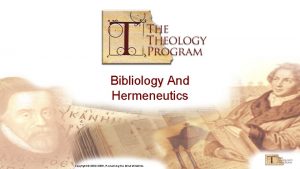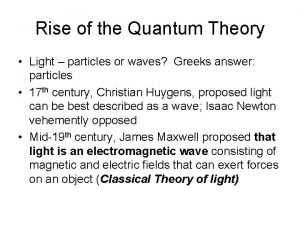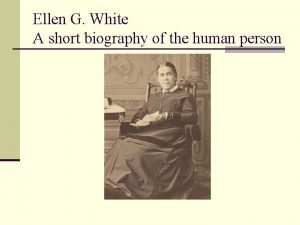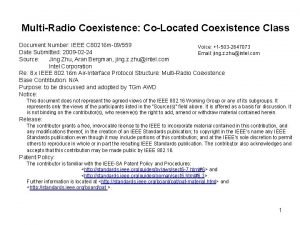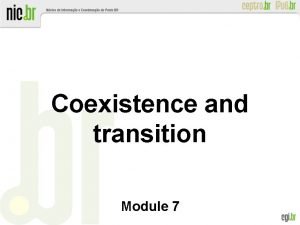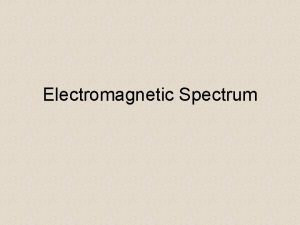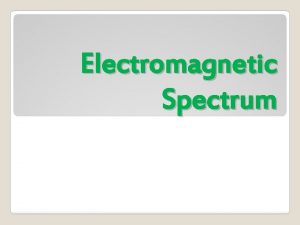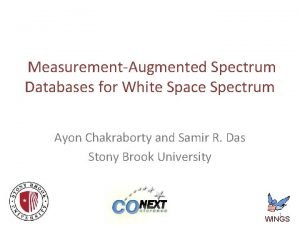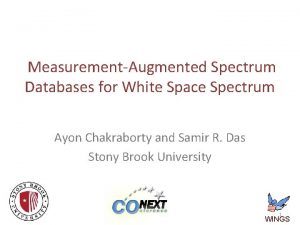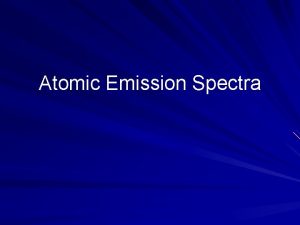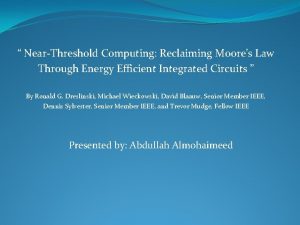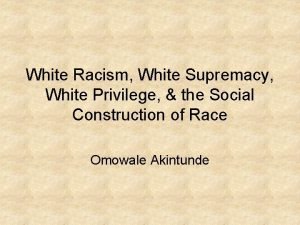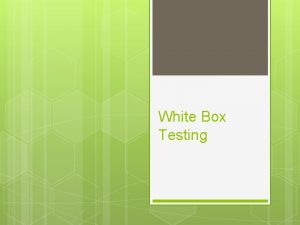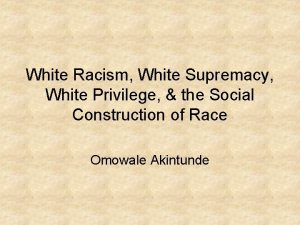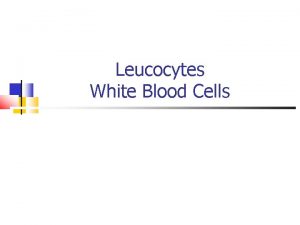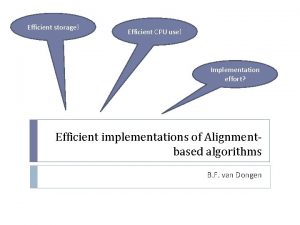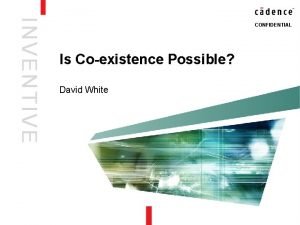Reclaiming the White Spaces Spectrum Efficient Coexistence with





























- Slides: 29

Reclaiming the White Spaces: Spectrum Efficient Coexistence with Primary Users George Nychis†, Ranveer Chandra§, Thomas Moscibroda★, Ivan Tashev§, Peter Steenkiste† †Carnegie Mellon University, §Microsoft Research, ★Microsoft Research Asia 1

What are White Spaces? Wireless Mic TV 0 54 -90 170 -216 470 MHz 700 -60 ISM (Wi. Fi) 2400 2500 “White spaces” } 5180 5300 7000 MHz 9 Orthogonal Channels (150 Mbps per chan) More Potential Applications Proliferation of Wireless & Mobile: dbm wireless broadband ISM Band is Insufficient to Meet Rural Demand Spectrum -100 Longer Range White Spaces 470 MHz Frequency 700 MHz City-wide mesh ……. . are Unoccupied TV Channels at least 3 - 4 x of Wi-Fi 2

White Space Availability Reclaiming the White Spaces • Spectrum availability is critical to adoption and goals Goal: “[to] make a significant amount of spectrum available for new innovative and services” – FCC 08 -260 Rescue Whiteand. Space by products Enabling Mic Coexistence • Spectrum is most critical in populated areas – Measure spectrum availability in top 30 U. S. cities [1] single channel Number of Analog TV Broadcasts Decreasing Over Time 53% of cities cannot support single 802. 11 2 Reserved Channels channel in the white spaces [1] Geo-location database: http: //whitespaces. msresearch. us/ Losing a Significant Amount of White Space to Mic Rules 3

Outline • Background on mic signals • Data transmission impact on mic audio – Critical insight on coexistence • SEISMIC: Spectrum Efficient Interference-Free System for MICs – Regains spectrum with zero audible interference – Evaluation of effectiveness and efficiency 4

Analog Microphone Background • One-way communication: receiver never transmits – Mic always transmitting (even idle) • Signal Components: Wireless Mic FM Modulated Audio Signal Mic Receiver Used By Mic Receiver to Detect Low Signal and Mute 5

Outline • Background on mic signals • Data transmission impact on mic audio – Critical insight on coexistence • SEISMIC: Spectrum Efficient Interference-Free System for MICs – Regains spectrum with zero audible interference – Evaluation of effectiveness and efficiency 6

How Do You Coexist to Reclaim Spectrum? • First in-depth analysis RF interference on mic audio quality – 3 Dimensions: time, frequency, and power • Study Impact on 6 Mics: – Audio Technica, Sennheiser (3), Shure, and Electro-Voice 7

Experimental Setup PESQ worldwide audio evaluation standard • Compare recording to original • 0 (total disruption) 1 (perfect) 1. PC Output to Speakers Mic 2. MIC Recording to Computer Mic Receiver White Space Device

Interference in Frequency • Fix power and duration, vary frequency (25 KHz steps) 1. Avoid Disruption, Still Use 97% of Channel 2. Suppression Req. Varies by Mic 9

Interference in Power • Fix freq. and duration, vary power of WSD (2 d. B steps) WSNm (d. B) WSNs (d. B) Despite 25 d. B of noise! Record in value of WSN m & WSN s when PESQ=1 “FM receivers exhibit a `capture • effect’ which they respond to only the strongest signal • received on a frequency and is No audio disruption when interference reject any weaker signals. ” just belowinterfering the squelch tones! (WSNs = 1 d. B) - FCC (First Order: 04 -113) 10

Implications of Interference Study • Coexistence in the same channel is possible! – Great! Just suppress bandwidth required at center frequency Not that simple… 11

The Challenge of Suppression Stronger WSD More Suppression `Perfect Suppression’ Actual Suppression would haveinsharp edge Leaks Power to the Band Weaker Mic More Suppression 12

Information Needed to Suppress • Two components needed at WSD to suppress properly: 1. WSD Interference Power at the Mic Receiver White Space Device (WSD) Mic Receiver Wireless Mic 2. Mic Signal Power at Mic Receiver 13

Lack of Information at WSD • No feedback on either required components – Without feedback, the system is open-loop – Must suppress “worst-case” to be conservative Given the open-loop state of the system (info available)… Unfortunately, worst-case is vacation! (6 MHz) … the FCC made the right decision by requiring vacation. 14

Need a Closed-Loop to Avoid Vacation Feedback SEISMIC Analysis Measurement Mic Receiver White Space Device) Adaptation Mic 15

Outline • Background on mic signals • Data transmission impact on mic audio – Critical insight on coexistence • SEISMIC: Spectrum Efficient Interference-Free System for MICs – Regains spectrum with zero audible interference – Evaluation of effectiveness and efficiency 16

SEISMIC System Overview • Implements closed-loop design to avoid vacation: – Measurement: Mic. Protector measures key components at receiver – Feedback: “Strobe” signal to notify WSD of impending disruption – Analysis / Adaptation: SEISMIC protocol to adapt frequency Feedback Mic. Protector White Space Device Mic Receiver Mic 17

Measurement: Mic. Protector • Key measurement needed: squelch & interference power – Squelch Measurement: estimated in the mic’s band – Interference Measurement: estimated in control bands Power in Mic Band Shifts Control Band Amplitude Control Band Interference Level 25 KHz Frequency 25 KHz 18

Feedback: Strobes • Mic. Protector needs to convey information to WSD • Strobe is similar to Morse-codes and on/off-keying (OOK) – Allows us to convey necessary information without complex protocol (e. g. , 802. 11) • Strobe signals convey: Amplitude – (1) impending disruption, (2) required bandwidth, (3) center frequency Frequency 19

Adaptation / Analysis: SEISMIC Protocol • WSD: sends probe packets with increasing power (exploit capture) • Mic. Protector: notifies of impending disruption, using strobes Control Band Amplitude Control Band Protection Threshold Interference Level 25 KHz Frequency 25 KHz 20

Adaptation: SEISMIC Protocol • WSD: sends probe packets with increasing power (exploit capture) • Mic. Protector: notifies of impending disruption, using strobes Suppressed Frequency (KHz) Strobe 250 250 200 150 100 Increase in Power Probe Convergence To Coexistence Mic. Protector Strobes the WSD for interference near threshold 50 WSD Mic. Prot. Pkts: Time 21

Summary of SEISMIC Design • Mic. Protector components: – detection of impending audio disruptions – feedback using strobes to WSD enables closed-loop – Note: can be built directly in to future receivers • WSD and Mic. Protector engage in SEISMIC protocol – converge to optimal suppression around mic • Formalization shows correctness with multiple WSD – WSDs will converge and never interfere, in paper SEISMIC 22

Outline • Background on mic signals • Data transmission impact on mic audio – Critical insight on coexistence • SEISMIC: Spectrum Efficient Interference-Free System for MICs – Regains spectrum with zero audible interference – Evaluation of effectiveness and efficiency 23

Evaluating SEISMIC • Full Mic. Protector and SEISMIC WSD prototypes – custom USRP 2 builds with UHF front ends • Evaluation on several coexistence points: – Effectiveness: ability to avoid audio disruption – Efficiency: ability to enable high spectrum re-use • Single microphone scenario • Many microphone scenario 24

Effectiveness of SEISMIC’s Coexistence • Challenge: Low-power & mobile microphone – SEISMIC WSD must never interfere despite mic signal fluctuations WSD continually Mobility creates and quickly quick fluctuations adapts to avoid audio disruption! WSD vacates channel when mic power is low to be safe 25

Efficiency of SEISMIC’s Coexistence • Evaluate efficiency under two mobile mic scenarios 1. 2. 1. Mic. Far mic (low/moderate signal) (high Mic Signal (d. Bm). . close WSD Signal (d. Bm) Distance (ft) WSDWSD Distance (ft)interference) 2. Far Mod. mic (moderate signal). . nearby WSD interference (50 -70) Close (moderate (5) Low (-95 -75) High (-50 -30) Moderate (10 -30) Moderate (-65) Moderate (15) Moderate (-70) Common scenario: 95% of time >5. 7 MHz Challenging scenario: 70% of time >5. 2 MHz 26

SEISMIC Efficiency with Many Mics • Obtain real mic freq placement from coordinators – Model components: 1) Mic signals, 2) WSDs & interference – Given components, how much spectrum does WSD X have? Event Mics 2008 NBA All-Star-Game 191 2010 BCS Championship 108 2010 WPC Conference 77 SEISMIC-enabled Mic System SEISMIC-enabled WSD • Mic signals generated using mobile mic measurements • Adaptrum WSD freq suppression w/ leakage used for WSDs 27

SEISMIC Spectrum Efficiency • On average, SEISMIC-enabled WSDs: – SEISMIC has 22 x, 3. 6 x, and 1. 6 x availability compared to channel vacation – SEISMIC near perfect suppression, suppresses only when necessary (closed-loop) – With 150 MHz: can support 7 150 Mbps channels! (2. 5 x 2. 4 GHz, with 4 x range) 28

Summary • Spectrum availability is critical to white spaces • Coexistence possible between WSD and mics – Closed-loop solution required to avoid vacation • SEISMIC enables disruption-free coexistence – Up to 95% of the spectrum can be regained • Demoed to FCC chairman, mic manufacturers, mic coordinators, audio community 29
 Personal archive migration
Personal archive migration Revolution of 1800 apush
Revolution of 1800 apush Bittitan coexistence
Bittitan coexistence The coexistence of good and evil
The coexistence of good and evil Coexistence
Coexistence Productively efficient vs allocatively efficient
Productively efficient vs allocatively efficient C b a d
C b a d Allocative efficiency vs productive efficiency
Allocative efficiency vs productive efficiency Productively efficient vs allocatively efficient
Productively efficient vs allocatively efficient Productive inefficiency and allocative inefficiency
Productive inefficiency and allocative inefficiency Reclaiming the mind ministries
Reclaiming the mind ministries Reclaiming and redefining the fundamentals of care
Reclaiming and redefining the fundamentals of care Absortpion
Absortpion Chromium orbital configuration
Chromium orbital configuration Spectrum white light
Spectrum white light Free verse poem examples for students
Free verse poem examples for students Ellen g. white henry nichols white
Ellen g. white henry nichols white Phối cảnh
Phối cảnh Một số thể thơ truyền thống
Một số thể thơ truyền thống Thế nào là mạng điện lắp đặt kiểu nổi
Thế nào là mạng điện lắp đặt kiểu nổi Lời thề hippocrates
Lời thề hippocrates Thế nào là hệ số cao nhất
Thế nào là hệ số cao nhất Slidetodoc
Slidetodoc đặc điểm cơ thể của người tối cổ
đặc điểm cơ thể của người tối cổ Cách giải mật thư tọa độ
Cách giải mật thư tọa độ Các châu lục và đại dương trên thế giới
Các châu lục và đại dương trên thế giới Sự nuôi và dạy con của hổ
Sự nuôi và dạy con của hổ Các loại đột biến cấu trúc nhiễm sắc thể
Các loại đột biến cấu trúc nhiễm sắc thể Chụp phim tư thế worms-breton
Chụp phim tư thế worms-breton Thẻ vin
Thẻ vin










